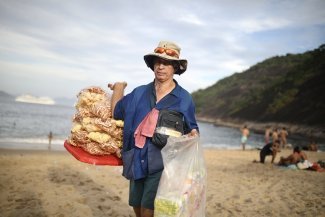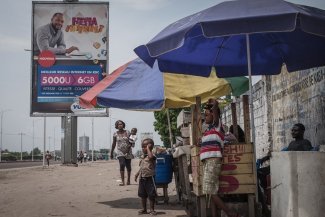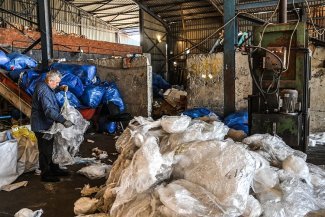One year after Hurricane Maria ravaged the United States territory of Puerto Rico, leaving more than 3000 dead and, at its peak, the entire island of 3.5 million residents without electricity, youth and labour activists are calling for a just energy transition that would better protect the island’s economy and energy system for future climate-related disasters.
“The transition to clean energy is very important because in Puerto Rico we suffered the onslaught of Hurricane Maria, and many of the deaths were people with health issues who depended on electric machines,” says Rosalina Alvarado, a science teacher and leader of the local environmental group, PANAS.
Maria made landfall as a Category 4 storm with sustained winds of 155 mph (250 km/h), making it the tenth-most intense Atlantic hurricane on record and the strongest tropical cyclone worldwide in 2017. Due to its size, it impacted the entire island of Puerto Rico, destroying entire neighbourhoods and adversely impacting an estimated 80 per cent of agricultural holdings.
In the immediate aftermath, communication to and from entire regions was cut off for several days, and it took 11 months to fully restore power.
Many have argued that the response by the United States federal government was severely lacking, and that this was partly to blame for it being the deadliest natural disaster to hit the country since the 1906 San Francisco earthquake.
“The community of Los Naranjos in Vega Baja [in the centre-north of the country], like many others in Puerto Rico, went six months without access to electrical power after Hurricane María,” says Koralis Reyes, leader of the Naranjo Watt project, a youth-led initiative to install solar energy in their community. “A just transition to renewable energy is not just about minimising the effects of climate change, it’s also about ensuring access to energy for everyone.”
There is mounting evidence that climate change will make storms like Hurricane Maria more frequent, putting small island states and coastal regions across the world at high risk. That is why Amira Odeh, a Puerto Rico based organiser for the international environmental movement 350.org, believes that more attention needs to be paid to local voices on the front lines of both the climate and social justice battlefronts.
“It is extremely important to listen to the voices of people in Puerto Rico,” says Odeh. “This is a country that will continuously suffer the effects of climate change like rising sea levels, higher temperatures, drought and is already living in the aftermath of a strong hurricane that cost the lives of thousands.”
“Electricity is a human right, not a commodity”
Besides the horrific human toll, one of Maria’s most lasting impacts has been on Puerto Rico’s energy system. It was heavily damaged, which is the main reason it took months to restore power. Even today, the grid is highly vulnerable to another natural disaster. However, current plans to rebuild the country’s electricity system are fraught will concerns, especially over Governor Ricardo Rosselló’s privatisation plan, which many fear would put the needs and desires of US or foreign investors ahead of locals. The Puerto Rican Union of Workers of the Electric and Irrigation Industry denounced this proposal, with their president, Ángel Figueroa Jaramillo, saying that “electricity is a human right and not a commodity.”
In fact, many unions and activists are calling for expanding public control of the grid, and increased investments in local clean energy projects that are owned and controlled by communities. Beyond keeping the grid under public control, this means restructuring the public utility company, PREPA (the Puerto Rico Electric Power Authority), by increasing worker control and making an energy transition an explicit goal. Advocates then believe that PREPA should work with communities to expand renewable energy options to everyone, not just, as many fear with privatisation, only those who can afford it.
“It is possible to create a new energy model in Puerto Rico where the utilities remain a public good and public investments are made to repair and update old failing infrastructure, while new infrastructure is built for a renewable energy future, all of which can be done and maintained by public sector workers,” says Irene Shen of Trade Unions for Energy Democracy (TUED), a global, multi-sector initiative to advance the democratic direction and control of energy.
TUED and others are concerned about the huge number of private US and global ‘clean energy’ companies coming to the island, which they see as ripe for renewables, but not factoring in either local input or other considerations.
These clean energy efforts are lacking as they rely on outside investors to both develop, implement and ultimately control energy systems, something some even call “green energy colonialism.” Combined with the Governor’s privatisation plan, there are fears that losing control of the territory’s grid could lead to higher energy costs in the future.
“The repair of the grid has already cost US$4 billion in public money,” says Shen. “This is another reason why privatisation would turn out to be a yard sale for the private corporations.” TUED and other civil society group will be keeping a close eye on the Puerto Rico Energy Commission’s Integrated Resource Plan. Due at the end of October, it will lay out a detailed and time-specific plan for the future of Puerto Rico’s electric power system, and observers are keen to see whether it includes provisions for community-based generation and has an ambitious renewable energy target.
Many island territories and nations are in similar situations to Puerto Rico – overly-dependent on imported fossil fuels and faraway corporations for their energy supply and infrastructure. By shifting to locally produced renewables, the opportunity to control both the production and distribution of energy could help rejuvenate the island’s economy and provide a model for the rest of the world.
“A just energy transition is key not only to solve the climate crisis but also to empower communities to manage their own energy systems, create their own employment opportunities and guarantee access to clean energy for everyone,” says Odeh.









